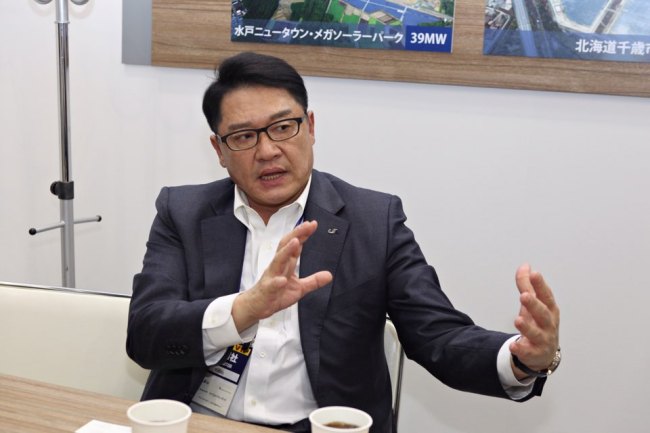TOKYO -- Amid the power industry’s shift toward digitalization worldwide, LSIS, South Korea’s largest power system and solution provider, is eyeing more M&A opportunities in the software sector to take the lead in the emerging smart grid market, its chief said last week.
“As a traditional power system provider, we face limitations in achieving organic growth particularly in the era of the ‘fourth industrial revolution,’” said Koo Ja-kyun, CEO and chairman of LSIS, in an interview on Wednesday. “We need to focus on converging software and information technology to the existing energy sector to better prepare for the future where we’ll see the rise of micro grids.”

LSIS CEO and Chairman Koo Ja-kyun speaks at an interview in Tokyo. He was visiting LSIS' booth set up for the Photovoltaic System Expo held in the capital city of Japan last week. (LSIS)
The 61-year-old chief was referring to micro grids or small-scale power grids that are widely said to be suitable for electricity generated from renewable energy sources. They are expected to replace the existing centralized power supply system, in which electricity generation and distribution are controlled by utility giants. Smaller-scale power grids require low and medium voltage solutions, an area in which LSIS has been taking the lead.
The power industry, one of the most traditional industrial sectors, has been going through a major transformation. The industry is being pressured by regulatory measures to curb carbon dioxide emissions and also by technological advances, such as the use of big data and artificial intelligence, to help reduce the intermittency of renewable energy sources, such as wind and solar power.
LSIS has spent years on research and development related to digitalizing power monitoring devices. But what it is looking for is the ability to build better and efficient grid infrastructure for connected devices, said Koo, adding that this is something that can be achieved through fast tracks like M&As.
LSIS’ pursuit of M&A opportunities comes after its acquisition of a US energy storage system unit from Parker Hannifin last year. Parker Hannifin is a leader in motion and control technologies, and its ESS business is the largest in the US, the company said. Energy storage systems save energy for the efficient distribution of power, storing electricity in the nighttime for daytime use.
The scholar-turned-businessman believes that though Parker Hannifin, LSIS has secured a favorable position in the US market, which sees the growing need for replacement of aging power supply systems. “Micro grids will be probably the better option for the US, in terms of time and money, than replacing aging supply infrastructure with new ones,” he said.
In addition to the US, LSIS has been expanding its presence as a solar plant builder in Japan, one of the major photovoltaic markets in the world.
Last year, it completed construction of a 28-megawatt solar plant, the largest PV power generator in Hokkaido, and won a 46 billion won project to build an 18-megawatt solar plant in Honshu, capable of providing electricity to 5,000 households a year.
To maximize profits in the growing market, LSIS aims to become a total energy provider in the solar plant business by offering a wide range of power solutions and invertor technology for photovoltaic power for both residential and commercial use.
“We have built a strong sales network here. ... I think the market potential here is indefinite for renewable energy used for residences,” he said.
Driven by thriving chip businesses, LSIS set a new sales record of 2.4 trillion won ($2.1 billion) last year. But the CEO said the target this year will not be higher than last year’s, citing companies being reluctant to make facility investment due to the slowing economy. “A key driver for LSIS’ performance will be from its global business, particularly from the renewable sector.”
South Korea, under its Renewable Energy 3020 plan, is also going through a major transformation toward green energy. It plans to increase renewable energy’s share of generation capacity to 20 percent from the current 7 percent by 2030, allocating funds amounting to 18 trillion won toward the project.
“I think it is a right way to go, but we need to figure out how to optimize our options,” said Koo, referring to the debate on Korea’s energy portfolio. Rather than going after global standards, Koo said the country needs to focus on what could be the best, considering mountains cover 70 percent of its land.
“I think floating PV generation on reservoirs or reclaimed land can be an opportunity for South Korea rather than cutting down trees to secure land for solar energy generation,” he said. “Maybe also on rice crop fields, with farmers receiving subsidies from the government,” he said.
Before joining LSIS in 2010, Koo was a professor of the Graduate School of International and Public Affairs in Korea University, teaching corporate finance. He holds a Ph.D. and Master of Arts from University of Texas at Austin.
By Cho Chung-un, Korea Herald correspondent
(
christory@heraldcorp.com)

![[AtoZ into Korean mind] Humor in Korea: Navigating the line between what's funny and not](http://res.heraldm.com/phpwas/restmb_idxmake.php?idx=645&simg=/content/image/2024/04/22/20240422050642_0.jpg&u=)
![[Exclusive] Korean military set to ban iPhones over 'security' concerns](http://res.heraldm.com/phpwas/restmb_idxmake.php?idx=645&simg=/content/image/2024/04/23/20240423050599_0.jpg&u=20240423183955)



![[Graphic News] 77% of young Koreans still financially dependent](http://res.heraldm.com/phpwas/restmb_idxmake.php?idx=645&simg=/content/image/2024/04/22/20240422050762_0.gif&u=)